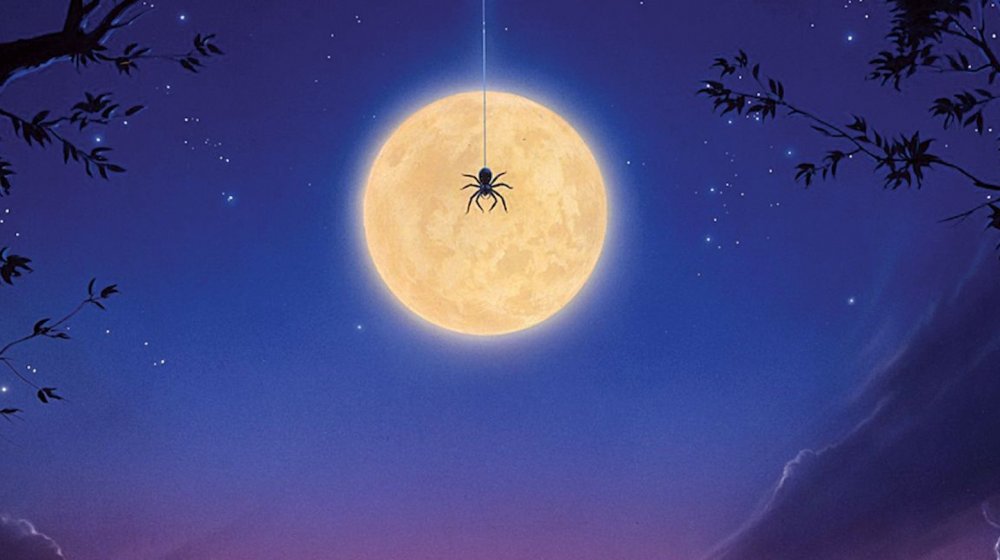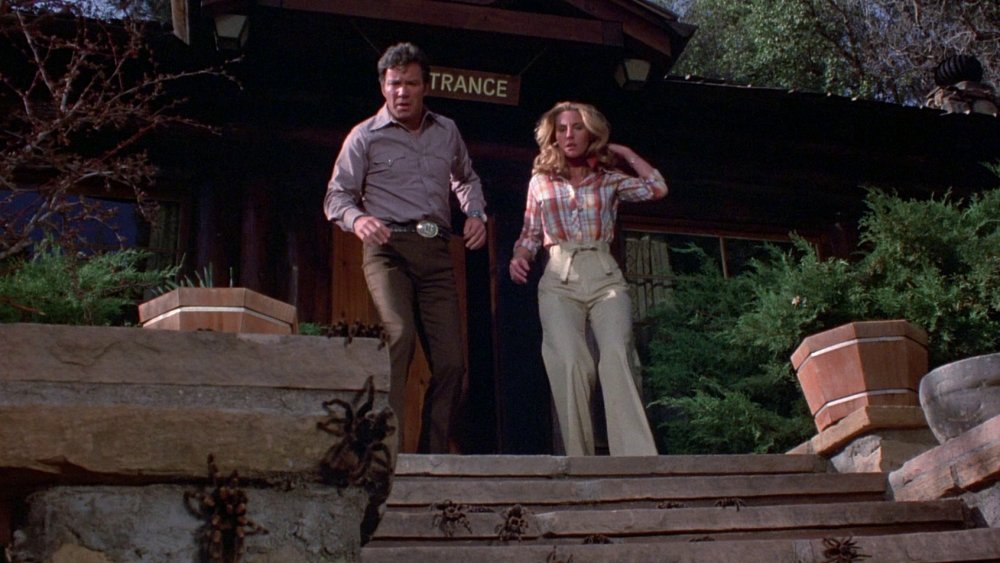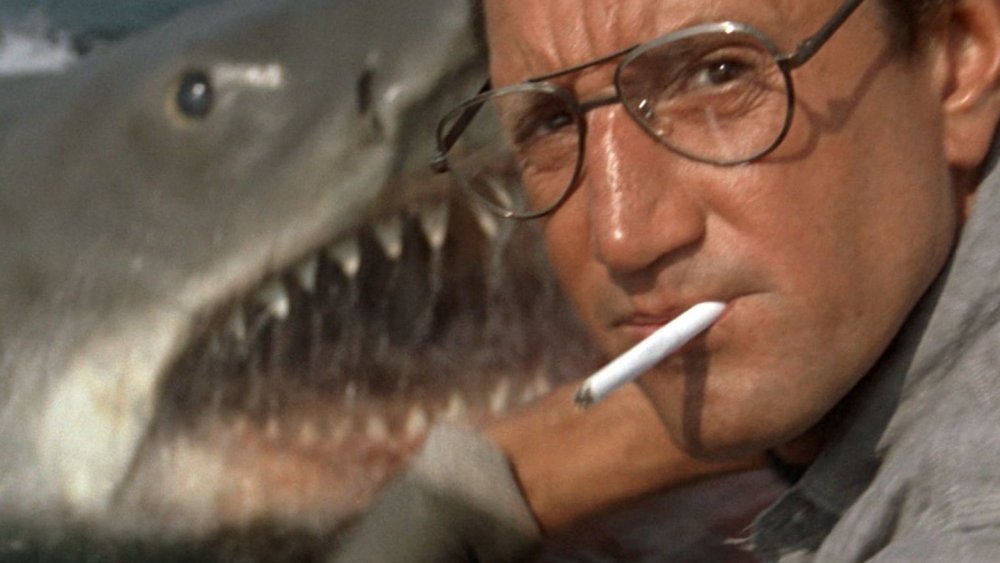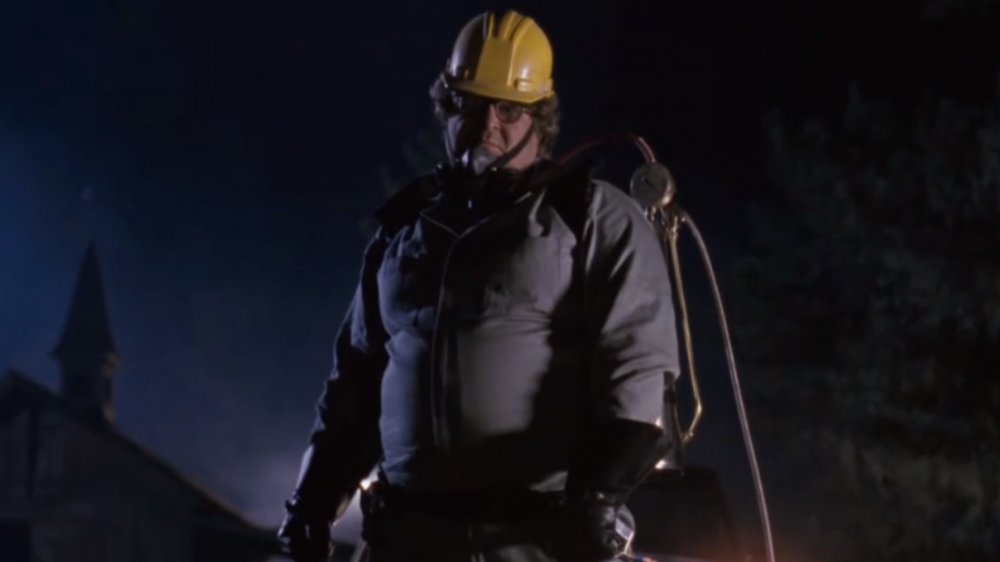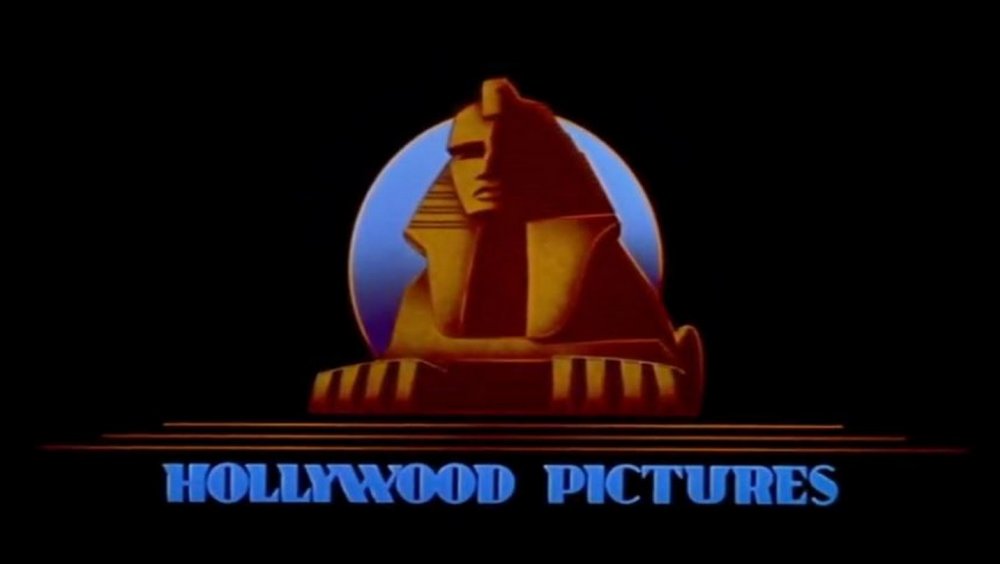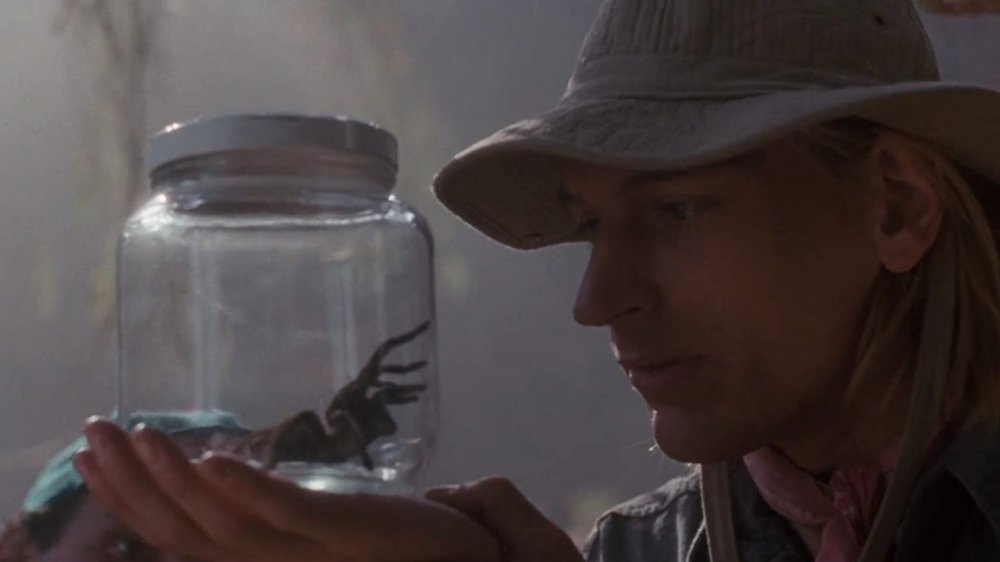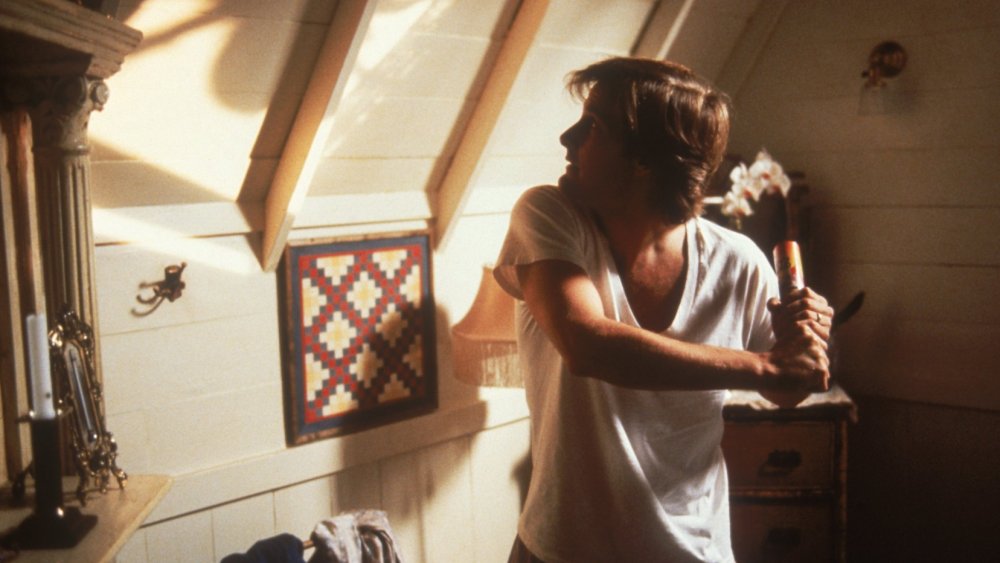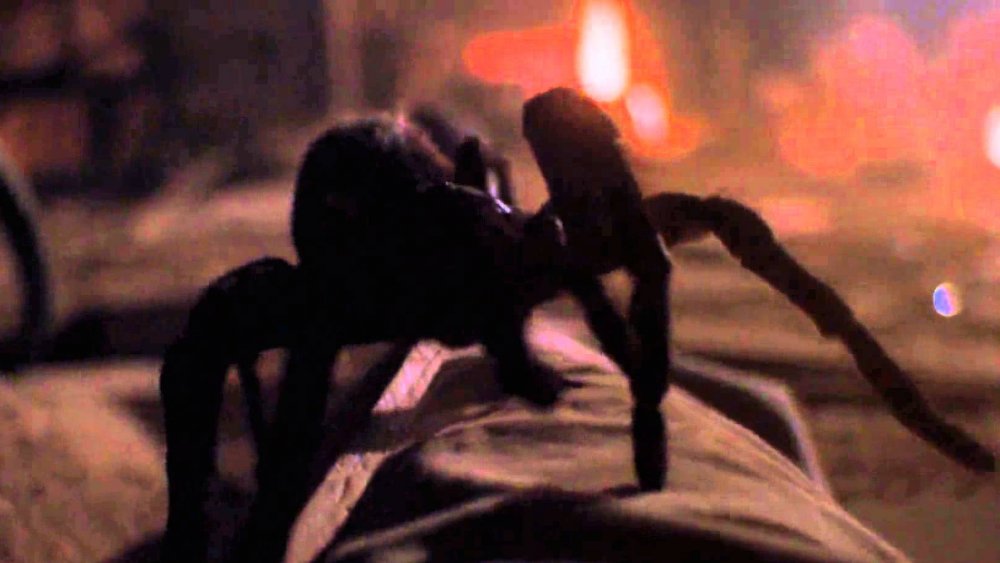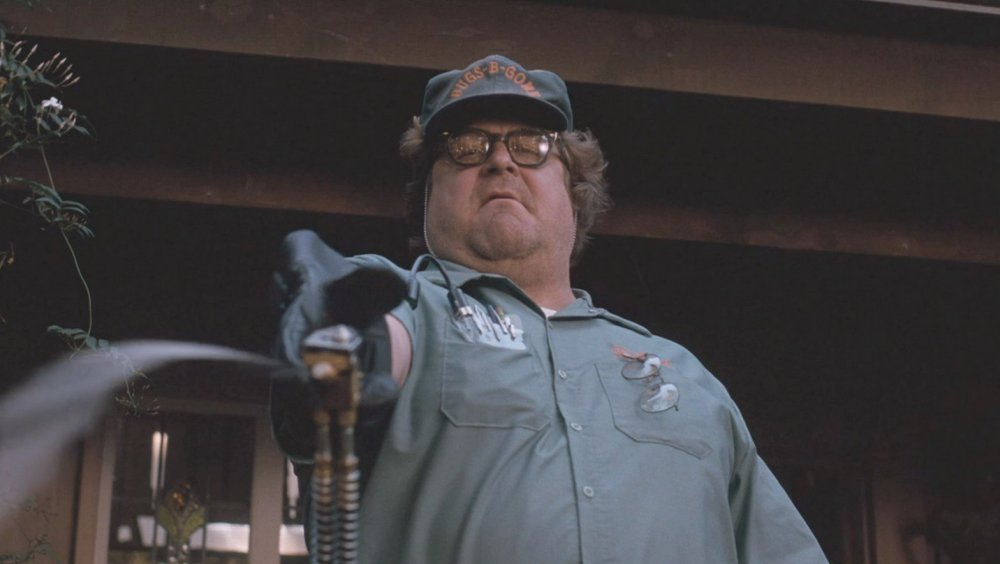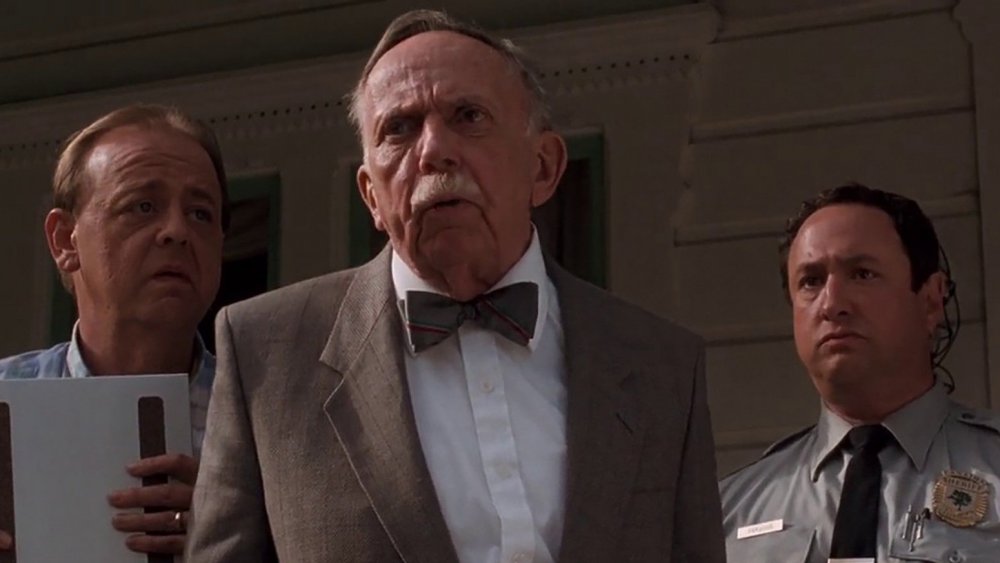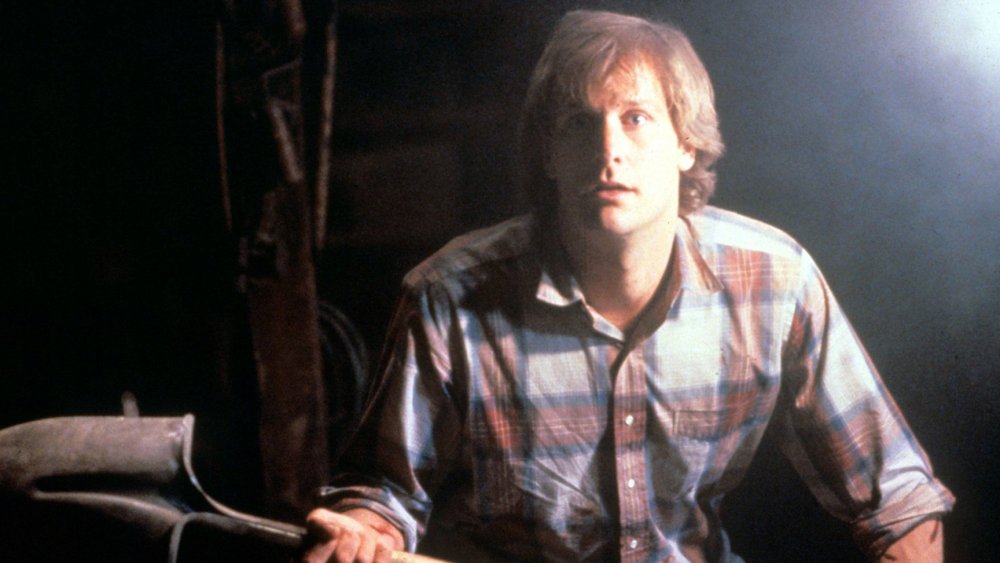Things You Missed About Arachnophobia As A Teen
Arachnophobia has been described as a "gateway" horror movie — it's creepy and icky and just scary enough to serve as an introduction to the horror genre without being too intense, controversial or frightening. Since this was a production from Amblin — the Steven Spielberg shop known for its PG or PG-13-rated genre fare — first-time director and Amblin producing partner Frank Marshall didn't set out to truly disturb anyone.
In the film, Jeff Daniels plays a doctor named Ross Jennings, who moves his family from the hectic environs of San Francisco to the small town of Canaima, California. They get there just in time for the arrival of a large, deadly spider that has hitched a ride in a coffin from Venezuela and soon begins spawning its own army of arachnids with the help of a local house spider. And coincidentally, Jennings himself has a fear of our eight-legged friends.
With its mix of an unnerving menace (who doesn't get weirded out by spiders?), oddball humor and quirky characters, Arachnophobia really was a horror movie for people — mostly youngsters — who had not seen a fright film before. But for many who first saw the movie as kids or even teens, there are things about Arachnophobia in terms of its history, development and storyline that could well have escaped your notice back then. With that in mind, here's a look back at some things you missed about Arachnophobia as a teen.
Shatner did it first
Arachnophobia wasn't the first movie to come out about killer insects or even killer spiders, and in fact, just 13 years before its release, another flick tackled the very same subject in a somewhat similar manner.
Back in 1977, William Shatner (in his wilderness years following the cancellation of Star Trek but before the movie series started up) starred in Kingdom of the Spiders, a low-budget film directed by former stuntman/actor John "Bud" Cardos. Shatner plays Dr. Robert "Rack" Hansen, a veterinarian in a remote area of Arizona who begins seeing a number of local farm animals dying from unexplainable causes. It turns out that a massive contingent of tarantulas, driven to starvation by the use of pesticides, are looking for a new food supply and starting to attack larger animals — including, eventually, humans.
Kingdom of the Spiders is a cult classic these days, mostly due to the presence of the Shat and an unusually bleak ending. The movie plays its horrors more seriously than Arachnophobia, but Kingdom's producer, Igo Kantor, has suggested that his movie provided some of the inspiration for Arachnophobia. He never pursued any sort of legal action about it, though, because "you don't go and sue Spielberg!"
The Jaws factor
Perhaps not surprisingly — since Steven Spielberg was involved with both movies — Arachnophobia shares a lot of plot and character parallels with Jaws. Of course, they are very different as well: Spielberg's 1975 breakout is one of the all-time great horror movies, while Arachnophobia is lighter fare overall. But the latter almost plays out like a land-based, eight-legged rewrite of Spielberg's classic man-vs.-man-eating-shark adventure.
In Jaws, New York City cop Martin Brody (Roy Scheider) takes a job as the chief of police in the quiet Long Island town of Amity to give his kids a better life and upbringing. In Arachnophobia, Jeff Daniels' Dr. Ross Jennings does the same thing, moving his family from San Francisco to a small hamlet in rural California.
Both men meet pushback from the local authorities once the town comes under siege, and both must also grapple with a fear unique to their situation: Brody, who moves to an island, doesn't care for the water, while Jennings, who relocates to a rural area, has a deathly fear of spiders. In the end, Brody and Jennings must overcome their fears directly to confront and defeat the monster — although their character arcs are slightly different.
There are different ways to tell any great story, and especially since some of the same people were involved in both movies, Jaws and Arachnophobia end up being variations on a time-honored tale.
What the hell is a 'thrill-omedy'?
Although we've been talking about Arachnophobia as a horror-comedy hybrid, with less of an emphasis on outright scares, the movie was in fact initially developed as a straight horror movie. But Frank Marshall nixed that, wanting to make a movie that was more like a rollercoaster ride. "We wanted it to be scary, but not too terrifying," Marshall said at the time. "We didn't want it to be a typical horror movie — The Spider That Ate Cleveland — so we used a lot of comedy... It's frightening, but in a fun way."
Marshall got his wish and Arachnophobia became a mixture of thrills and laughs. The trouble is, the studio distributing the movie (Hollywood Pictures, a subsidiary of Disney) had no idea how to market it. Should they aim it at horror fans? Comedy fans? Families? How do you sell a movie that genre-hops like this one?
The answer was a term used for the first and only time on Arachnophobia: "thrill-omedy," which not only looked weird in the ads at the time, but rolled off the tongue about as smoothly as one of the movie's creepy-crawler villains. While the intent seems clear enough, the word still looks and sounds like someone wants to take your temperature as you watch the movie. Luckily, the clumsy term didn't affect the film's bottom line at the box office, but thankfully we never saw another movie billed as a "thrill-omedy" again.
Hooray for Hollywood
You might not have realized it at the time (because we didn't pay nearly as much attention to things like this back then), but Arachnophobia was released by Hollywood Pictures, an offshoot of Disney that was supposed to be a venue for older-skewing fare. In fact, Arachnophobia was the first picture to come out under the Hollywood banner when it arrived in theaters on July 18, 1990, and seemed to be a good indicator of the kinds of films the division would make — films that could be enjoyed by older kids and their parents.
Initially, the idea seemed to work: Arachnophobia was a box office success, grossing more than $53 million domestically against a $22 million budget. In the end, the hits were more sporadic than plentiful, although when a Hollywood Pictures movie rang an audience's bell, it chimed loud and hard. 1992's The Hand That Rocks the Cradle earned $88 million, while 1996's The Rock raked in $335 million and 1999's The Sixth Sense grabbed a monster $672 million plus an armful of Academy Award nominations.
Other hits included Tombstone, Crimson Tide and The Joy Luck Club, but unfortunately a majority of the 50 films released under the Hollywood flag turned out to be clunkers at the box office and not critical favorites either (anyone remember Simon Birch?). The label was shut down in 2001, briefly revived as a genre brand in 2006, and shut down again a year later — but hey, it did give us Arachnophobia and a few other gems.
Spiders are our friends
From the start, Arachnophobia positions spiders — whether deadly giant arachnids from Venezuela or common house spiders in California — as a terrifying enemy of humankind. But although the spiders in Arachnophobia claim their share of victims and the climax features Jeff Daniels literally in hand-to-leg combat with a giant Venezeulan spider in a burning basement, the truth is that spiders are not generally aggressive toward humans and have no interest in attacking us.
According to experts, spiders are not interested in humans and are only peripherally aware of our existence. Unlike insects like mosquitoes and ticks, spiders don't feed on human blood and are much more likely to bite other spiders or insects. Spiders tend to bite humans only when they feel threatened and have no choice but to defend themselves.
Spiders that are actually medically dangerous to humans are rare in North America, and even the infamous black widow doesn't want to kill you. As for spider venom, even if you are bitten, there are quick medical remedies for most types. There are even medicinal properties to certain types of spider venom that could help with things like muscular dystrophy, Alzheimer's disease and the ever-popular erectile dysfunction.
How to train your spider
No doubt as you watched Arachnophobia for the first time way back when, you marveled at the way that the spider wranglers got their subjects to perform on command. You probably sat there in the darkness of the movie theater and thought "How did they train all the spiders to act and move the way they wanted as soon as the cameras began rolling?"
The short answer is, you can't. Spiders are basically untrainable. "You can't actually teach them to do anything," said entomologist Steven Kutcher, who was in charge of wrangling the live spiders on the set. "You just watch what they do, then figure out how you can apply it to what you want them to do."
While the spiders couldn't actually be taught to move or march, they could be directed by other means. The critters disliked household cleaner Lemon Pledge, for example, so Kutcher sprayed it around them on the set to keep them confined to one section. Hot air from blow dryers also kept the bugs from wandering off their marks. When the insects were required to perform certain specific motions, they were gently pulled either through thin leashes attached to their bellies with a dab of wax or by the use of tiny metal plates controlled via electromagnets. The scenes involving the movie's tiny stars, understandably, took hours to film.
Big Bob is ready for his close-up
Hundreds of members of a smaller species known as an Avondale spider were shipped to the production to play the hordes of arachnids rampaging around Canaima, with an initial cast of 300 that was refreshed every two weeks. The arachnids were originally from New Zealand and said to be harmless to humans. But for the lead spider — the deadly Venezuelan monster that rides back to the U.S. in the coffin of a photographer it killed — something more was required.
The filmmakers found their eight-legged star through a Los Angeles business called Reptile Rentals. The place owned a giant bird-eating tarantula — the only one of its kind in the U.S. — with a leg span of more than eight inches. To make him look even more terrifying, the spider had purple markings painted on his back, while a fake prosthetic abdomen was strapped onto him to increase his overall bulk.
The film's non-human star was given the name Big Bob in honor of Back to the Future director Robert Zemeckis. Unlike the Avondale spiders, Big Bob could deliver a bad bite, so everyone had to be careful around him on the set. For some of the more complicated shots (like the final battle with Jeff Daniels), an animatronic Big Bob was built by Jamie Hyneman, back then a budding special effects artist but now known to many as one of the stars of Mythbusters.
Spider safety
The hundreds of live spiders on the Arachnophobia set were wrangled by Steven Kutcher and spider coordinator Jim Kundig, who ensured that no living spiders were harmed during the filming of the movie. When dead spiders were required, the bodies of arachnids who had previously passed away from natural causes were used.
But what about scenes in which spiders were killed onscreen? We see John Goodman spray insecticide at one such creature before stepping on it, while a child drops a book directly on another in a different scene. In both those cases and others, special props were made to guarantee the insect's safety.
For the insecticide shot, the actor simply sprayed a rubber spider. For the next shot in which he squished the thing underfoot, Goodman's boot had a hollow, padded bottom where the spider could go. "It would just curl up inside and wait for the next take," Goodman told Entertainment Weekly. Similar measures were taken for the book-smashing scene. According to multiple reports, not a single spider was killed during the making of the movie. "You have to realize from day one of shooting that the spiders come first," Jeff Daniels joked at the time.
Whatever happened to Sheriff Parsons?
The annoying Sheriff Lloyd Parsons (Stuart Pankin, on the right in the photo), chief law officer of Canaima, California, is one of the movie's main antagonists (aside from the spiders). He challenges, questions and harasses Dr. Jennings every step of the way, disbelieving his theories on the rash of unexplained deaths in the town and fighting the new doc's efforts to have the bodies exhumed and autopsied.
After Parsons and entomologist James Atherton (Julian Sands) discover that the spider's lair is located in the Jennnings' barn, Atherton commands Parsons to go back to the mortuary and pick up Jennings, Atherton's assistant Chris Collins (Brian McNamara) and exterminator Delbert McClintock (John Goodman). But after Parsons rides off, we never see him again in the film. So what happened?
It turns out that Parsons was also a victim of the spiders, and that his death scene was filmed but dropped from the final cut. In the scene, Parsons is driving to the mortuary when an arachnid lodged inside his car attacks the lawman and causes his cruiser to crash. It's an ignominious ending for a dislikable character, made even more insulting by the fact that it wasn't deemed important enough to show (and that's got nothing to do with Pankin, the actor, who we're sure is a very nice person).
Move to the country... or not
We've already discussed the similarities between Jaws and Arachnophobia. In both movies, the protagonist — Chief Brody in Jaws and Dr. Jennings in Arachnophobia — moved their families from big cities (New York City in the former, San Francisco in the latter) to tiny communities that were respectively on the water or out in the country.
Lots of times in the movies, living in the country is seen as something beneficial and ultimately more rewarding than urban life — see Michael J. Fox's Doc Hollywood, for instance. Indeed, Jaws ends with Chief Brody admitting that he's starting to like the water after all... and it's hinted that he and his family are not going to leave Amity anytime soon.
Arachnophobia is different. Even though (spoilers here) Dr. Jennings defeats the spiders and overcomes his fear of them, the movie ends with the family back in San Francisco — where an earthquake reminds them that this particular city has its own problems with nature. But the ending is unusual in that, instead of realizing they like the country after all, the Jennings pull up stakes and head back to city life — where quakes are apparently preferable to spiders.
